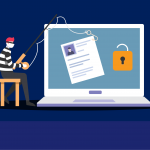
A data breach is an unauthorized access, disclosure, or destruction of confidential or sensitive information. This can occur due to hacking, phishing, or other cyber attacks, as well as human error or negligence. Data breaches can lead to identity theft, financial fraud, and other forms of harm to individuals or organizations whose data has been compromised.
Here are some statistics related to data breaches:A data breach is a security incident that involves the unauthorized access, disclosure, or theft of sensitive or confidential information. This can happen in various ways, such as through hacking, social engineering, or accidental exposure of data. The compromised data can include personal information such as names, addresses, social security numbers, and financial information such as credit card numbers or bank account details. Data breaches can have serious consequences for individuals, businesses, and organizations, including financial losses, reputational damage, legal consequences, and identity theft. It is important to take measures to prevent data breaches and to respond quickly and effectively in the event of a breach.
- The average cost of a data breach globally was $4.24 million in 2021. (Source: IBM Security)
- In 2020, the healthcare industry had the highest average cost of a data breach, at $7.13 million. (Source: IBM Security)
- 37% of organizations experienced a security breach in 2020, up from 32% in 2019. (Source: Ponemon Institute)
- The average time to identify and contain a data breach is 287 days. (Source: IBM Security)
- Malicious attacks are the most common cause of data breaches, accounting for 52% of incidents. (Source: Verizon Data Breach Investigations Report 2021)
- The top three types of data compromised in data breaches are personal information, such as names and addresses (58%), login credentials (45%), and financial data (36%). (Source: Verizon Data Breach Investigations Report 2021)
- These statistics highlight the prevalence and impact of data breaches and the need for effective measures to prevent and respond to such incidents.
- Financial losses: Companies can face significant financial losses due to the costs of investigating and mitigating the breach, as well as potential legal fees, fines, and compensation to affected individuals.
- Reputational damage: A data breach can damage a company’s reputation and erode consumer trust, leading to lost business and reduced revenue.
- Legal and regulatory consequences: Companies may face legal action from individuals or regulators for failing to protect sensitive data, or for violating data privacy laws and regulations.
- Operational disruption: Dealing with a data breach can be time-consuming and distract from normal business operations, leading to reduced productivity and revenue.
- Loss of intellectual property: Data breaches can also result in the theft of valuable intellectual property, such as trade secrets or proprietary information, which can have long-term consequences for a company’s competitiveness.
- In short, the impact of a data breach on a company can be severe and long-lasting and can affect a range of aspects, including financial, operational, and reputational aspects of the business.
- Identity theft: A data breach can expose sensitive personal information, such as names, addresses, Social Security numbers, and credit card information, which can be used for identity theft and fraud.
- Financial loss: If a user’s financial information is exposed in a data breach, they may be at risk of financial loss due to fraudulent charges, unauthorized withdrawals, or other financial crimes.
- Reputation damage: In some cases, a data breach may expose sensitive or embarrassing personal information, which can damage a user’s reputation or cause emotional distress.
- Cyberstalking or harassment: If personal information is exposed in a data breach, a user may become a target of cyberstalking, harassment, or other forms of online abuse.
- Phishing scams: Data breaches can also lead to an increase in phishing scams, where attackers attempt to trick users into revealing their personal information or installing malware on their devices.
- In summary, data breaches can have a range of negative impacts on normal internet users, including financial loss, identity theft, reputation damage, and increased vulnerability to cyberattacks. It is important for users to take measures to protect their personal information and monitor their accounts for signs of unauthorized activity.
- Use strong, unique passwords for all your accounts and change them regularly.
- Enable two-factor authentication (2FA) whenever possible, which adds an extra layer of security to your accounts.
- Be cautious of phishing scams and only click on links or download attachments from trusted sources.
- Keep your software and operating systems up to date with the latest security patches and updates.
- Use a reputable anti-virus or anti-malware program and keep it updated.
- Avoid using public Wi-Fi networks for sensitive transactions, such as banking or online shopping.
- Regularly monitor your financial and online accounts for any suspicious activity.
- Be mindful of the information you share online, including on social media, and avoid oversharing personal information.
- Consider using a password manager to help generate and store strong, unique passwords for your accounts.



